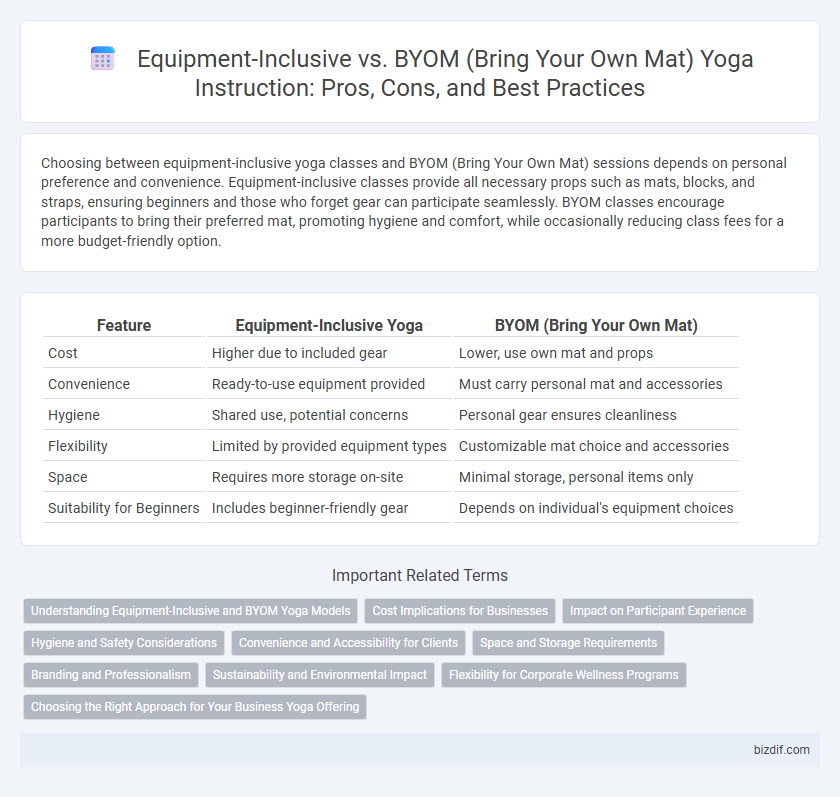Choosing between equipment-inclusive yoga classes and BYOM (Bring Your Own Mat) sessions depends on personal preference and convenience. Equipment-inclusive classes provide all necessary props such as mats, blocks, and straps, ensuring beginners and those who forget gear can participate seamlessly. BYOM classes encourage participants to bring their preferred mat, promoting hygiene and comfort, while occasionally reducing class fees for a more budget-friendly option.
Table of Comparison
| Feature | Equipment-Inclusive Yoga | BYOM (Bring Your Own Mat) |
|---|---|---|
| Cost | Higher due to included gear | Lower, use own mat and props |
| Convenience | Ready-to-use equipment provided | Must carry personal mat and accessories |
| Hygiene | Shared use, potential concerns | Personal gear ensures cleanliness |
| Flexibility | Limited by provided equipment types | Customizable mat choice and accessories |
| Space | Requires more storage on-site | Minimal storage, personal items only |
| Suitability for Beginners | Includes beginner-friendly gear | Depends on individual's equipment choices |
Understanding Equipment-Inclusive and BYOM Yoga Models
Equipment-inclusive yoga classes provide all necessary props such as mats, blocks, straps, and blankets, enhancing accessibility and convenience for beginners and travelers. BYOM (Bring Your Own Mat) models prioritize personal hygiene and individual preferences, attracting practitioners who prefer using their own gear for comfort and familiarity. Understanding these models helps yoga instructors tailor their sessions to client needs, balancing convenience with hygiene and customization.
Cost Implications for Businesses
Offering equipment-inclusive yoga classes typically involves higher upfront costs for businesses, including purchasing mats, blocks, straps, and cleaning supplies, which can impact profit margins. On the other hand, BYOM (Bring Your Own Mat) reduces operational expenses and maintenance requirements but may limit class accessibility for guests without personal equipment, potentially affecting enrollment rates. Balancing these cost implications requires strategic consideration of target demographics and pricing models to optimize revenue and customer satisfaction.
Impact on Participant Experience
Offering equipment-inclusive yoga classes enhances participant experience by providing high-quality mats, blocks, and straps, ensuring consistency and comfort for all skill levels. BYOM (Bring Your Own Mat) encourages personal preference and hygiene but may lead to variability in mat quality and comfort, potentially affecting practice stability and alignment. Equipping studios minimizes barriers to participation and fosters a more inclusive and uniform environment, optimizing user engagement and satisfaction.
Hygiene and Safety Considerations
Yoga studios offering equipment-inclusive classes provide sanitized mats and props, reducing the risk of cross-contamination and promoting consistent hygiene standards. BYOM (Bring Your Own Mat) policies empower practitioners to maintain personal cleanliness but require diligent cleaning routines to prevent bacterial buildup and ensure safety. Choosing between these options involves balancing convenience with rigorous hygiene practices to support a safe and healthy yoga environment.
Convenience and Accessibility for Clients
Equipment-inclusive yoga classes provide convenience by eliminating the need for clients to bring their own mats and accessories, making it easier for beginners and travelers to participate without extra preparation. BYOM (Bring Your Own Mat) policies enhance accessibility by encouraging clients to use familiar, personal mats that ensure comfort and hygiene, appealing especially to regular practitioners who prioritize personalized practice spaces. Offering both options can accommodate diverse client preferences, ultimately increasing overall participation and satisfaction in yoga sessions.
Space and Storage Requirements
Yoga studios offering equipment-inclusive classes require ample space and dedicated storage solutions to accommodate mats, blocks, straps, and bolsters for all participants. BYOM (Bring Your Own Mat) classes significantly reduce storage needs, allowing studios to optimize floor space and streamline class turnover. Efficient space management is crucial for studios balancing equipment-inclusive amenities with maintaining open, clutter-free practice areas.
Branding and Professionalism
Offering equipment-inclusive yoga classes enhances brand professionalism by demonstrating commitment to client comfort and convenience, reinforcing a premium image. BYOM (Bring Your Own Mat) models emphasize personalization and flexibility but may dilute brand consistency and perceived quality, impacting client retention. Clear communication of equipment policies aligns expectations and strengthens brand identity in competitive yoga markets.
Sustainability and Environmental Impact
Equipment-inclusive yoga studios reduce plastic waste by providing eco-friendly mats and props, supporting sustainable materials like natural rubber and cork. BYOM (Bring Your Own Mat) minimizes resource consumption by encouraging practitioners to reuse personal equipment, thereby decreasing demand for mass-produced, synthetic mats. Both approaches promote environmental responsibility, but equipment-inclusive options enable controlled sourcing of sustainable products, while BYOM prioritizes individual reduction of carbon footprint and waste.
Flexibility for Corporate Wellness Programs
Corporate wellness programs benefit from supplying equipment-inclusive yoga sessions, ensuring uniformity in quality and hygiene standards. BYOM (Bring Your Own Mat) options offer flexibility and convenience, accommodating personal preferences and reducing setup costs. Balancing both approaches allows organizations to tailor yoga offerings that enhance employee engagement and overall program success.
Choosing the Right Approach for Your Business Yoga Offering
Offering equipment-inclusive yoga classes attracts beginners and convenience-seeking clients by providing mats, blocks, and straps, enhancing accessibility and reducing barriers to entry. BYOM (Bring Your Own Mat) models lower operational costs and appeal to eco-conscious practitioners who prefer personal hygiene and comfort with familiar equipment. Analyzing target demographics and business goals helps determine whether an equipment-inclusive or BYOM approach optimizes client satisfaction and long-term retention.
Equipment-inclusive vs BYOM (Bring Your Own Mat) Infographic

 bizdif.com
bizdif.com